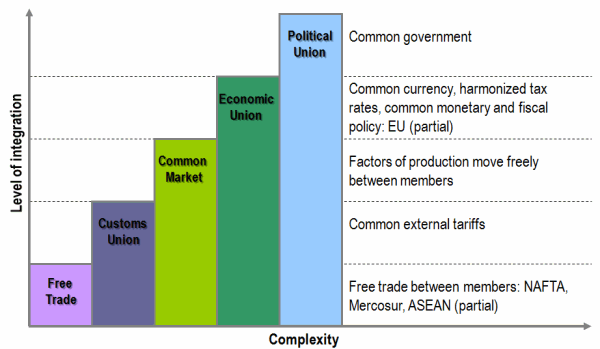|
Front
|
Back
|
General Agreement on Tariffs and Trade (GATT)
|
General Agreement on Tariffs and Trade (GATT) = international agreement that sponsors negotiations to promote world trade.
The GATT’s goal was to promote a free and competitive international trading environment benefiting efficient producers, an objective supported by many multinational corporations (MNCs); the GATT accomplished this by sponsoring multilateral negotiations to reduce tariffs, quotas, and other nontariff barriers.
|
Most Favored Nation Principle
|
To help international businesses compete in world markets regardless of their nationality, the GATT sought to ensure that international trade was conducted on a nondiscriminatory basis; this was accomplished through use of the most favored nation (MFN) principle.
Most favored nation (MFN) principle – requires that any preferential treatment granted to one country must be extended to all countries.
There are two important exceptions to the MFN principle:-To assist poorer countries in their economic development efforts, the GATT permitted members to lower tariffs to developing countries without lowering them for more developed countries (generalized system of preferences).-The second exemption is for comprehensive trade agreements that promote economic integration, such as the EU and NAFTA.
|
Role of the World Trade Organization
|
The eighth and final round of
GATT negotiations began in Uruguay in 1986; the participants agreed to
create the WTO; the World Trade
Organization came into being on January 1, 1995.
- Headquartered in Geneva,
Switzerland, as of May 2006 the WTO includes 149 member and 32 observer
countries.
- Members are required to open
their markets to international trade and to follow the WTO’s rules.
- The WTO has three primary
goals:
- 1) Promote
trade flows by encouraging nations to adopt nondiscriminatory, predictable
trade policies.
- 2) Reduce
remaining trade barriers through multilateral negotiations
- 3) Establish
impartial procedures for resolving trade disputes among members.
|
|
|
- The WTO faces a variety of challenges.
- One is dealing with sectors of the economy that seemingly receive government protection in every country. Two such sectors are agriculture and textiles.
- The Cairns Group of major agricultural exporters led by Argentina, Australia, Brazil, Canada, and Thailand = pressuring other WTO members to ensure the Doha Round significantly reduces barriers to agricultural trade.
- Similarly, trade in textiles had been governed since 1974 by the Multifibre Agreement, which created a complex array of quotas and tariffs.
- Another challenge facing the WTO is reducing barriers to trade in services.
- The Uruguay Round developed a set of principles under which such trade should be conducted; one nondiscriminatory approach is the use of national treatment, whereby a country treats foreign firms the same way it treats domestic firms.
|
|
|
- The TRIMS agreement in the Uruguay Round is but a modest start toward eliminating national regulations on FDI that may distort or restrict trade.
- The TRIMS agreement affects:
- -Trade-balancing rules: Countries may not require foreign investors to limit their imports of inputs to an amount equal to their exports of local production.
- -Foreign-exchange access: Countries may not restrict foreign investors’ access to foreign exchange.
- -Domestic sales requirements: Countries may not require the investor to sell a percentage of a factory’s output in the local market.
|
|
|

Regional trading blocs differ significantly in form and function. The characteristic of most importance to international businesses is the extent of economic integration among a bloc’s members. This is of utmost importance because it affects exporting and investment opportunities available to firms from member and nonmember countries. There are five different forms of regional economic integration: free trade area, customs union, common market, economic union, and political union.
|
|
|
- A free
trade area encourages trade among its members by eliminating
trade barriers among them.
- At the lowest level there is
the preferential trade area, this means that the members charge each
other lower tariffs than those applicable to non-members, however there
is no free movement of goods within the area.
- A free trade area means that
the barriers and quotas to mutual trade are removed.
- Ex: members of the North
American Free Trade Area (NAFTA), Canada, Mexico & United States,
pledge to do away with barriers to mutual trade.
- Unlike a customs union, each
member continues to determine its own commercial relations with
non-members.
- Trade
deflection – nonmembers reroute (or deflect) their
exports to the member nation with the lower external trade barriers.
- Rules
of origin – detail the conditions under which a good
is classified as a member good or a nonmember good.
|
|
|
- A customs
union combines the elimination of internal trade barriers
among its members with the adoption of common external trade policies
toward nonmembers.
- A customs union goes further
than a Free Trade Area and requires its members to implement a common
external tariff on imports from outside the Union, whereby the aim is to
facilitate goods to move freely throughout the union.
|
|
|
- Common market – form of regional economic integration that combines features of a customs union with elimination of barriers inhibiting the movement of factors of production among members
- The creation of a common market is the next step, whereby the obstacles for the free movement of labor, capital, services and persons are eliminated.
- The instruments necessary to establish a common market are: a trade liberalisation programme; common external tariff; the coordination of macroeconomic policy; and the adaptation of sectoral agreements.
- The single market with the "four freedoms" - the free movement of goods, services, persons and capital - forms the core of the European Common Market.
|
|
|
- An economic union represents full integration of the economies of two or more countries.
- The establishment of an economic union entails a common currency and/or the harmonization and unification of monetary, fiscal and social policies
Ex: the Economic and Monetary Union within the EU
|
|
|
- A political
union is the complete political as well as economic
integration of two or more countries, thereby effectively making them on
country.
- As already indicated, the
weaker forms of international political integration refer to cooperation
between states and formations of state-based regimes.
- The deeper forms of
integration refer to the constitution of new political entities, which
have a certain degree of independence in regard to the individual
states.
- Thus, political integration
involves the strengthening of a political system, in particular the
scope and capacity of its decision-making process.
- Besides this institutional
aspect of integration, there is as well the normative dimension of
creating a political community.
|








